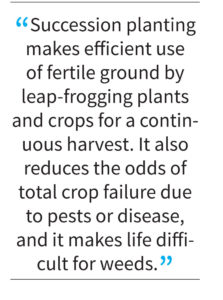Your Garden … with Kate Russell – Gilroy gardeners can grow food year-round with succession planting
Published in the September 5 – 18, 2018 issue of Gilroy Life
Living in Gilroy makes it possible to grow food year-round. Instead of simply planting in spring, Gilroy gardeners can use the same space all year with succession planting.
Succession planting makes efficient use of fertile ground by leap-frogging plants and crops for a continuous harvest. It also reduces the odds of total crop failure due to pests or disease, and it makes life difficult for weeds.
Finally, planting fast-growing crops with slow-growing crops makes good use of soil that might have otherwise gone fallow.
In its simplest form, succession planting refers to following one crop with another crop. This is generally done as the weather changes, following a summer crop with a cool season crop. In addition to this consecutive planting, there is also staggered planting, varietal planting, and intercropping.
 Staggered planting refers to planting seeds of the same plant in the same area, but on different days. This extends the harvest season, providing a continuous, smaller harvest of the same plant. Staggered planting is best suited for lettuce, spinach, radishes, beets, carrots, and peas. For most of these crops, you can start a new set of seeds every week or two, for maximum production.
Staggered planting refers to planting seeds of the same plant in the same area, but on different days. This extends the harvest season, providing a continuous, smaller harvest of the same plant. Staggered planting is best suited for lettuce, spinach, radishes, beets, carrots, and peas. For most of these crops, you can start a new set of seeds every week or two, for maximum production.
Varietal planting means installing different varieties of the same plant in the same place, at the same time. These varieties have different maturity dates. You can grow early, mid-season, and late-season maturing varieties, for a continuous harvest. You may even be able to squeeze in another early harvest at the end of the season.
Intercropping puts different crops together in the same place, at the same time. This allows gardeners to make use of soil resources that might have gone unused with a single crop. It also increases biodiversity, reducing potential pest and disease problems. One example of intercropping is the Three Sisters Method of growing beans, corn, and squash together.
Intercropping is the scientific basis behind the companion planting craze. Unfortunately, there are no magic pairings of plants that “like” each other. Instead, there are structural and developmental needs of different plants that either support one another, or don’t interfere with each other, while growing in the same space.
Basic intercropping pairings include climbing plants with tall, sturdy plants, shade-loving plants under large-leafed sun lovers, or root crop plants with plants that put most of their structure aboveground.
To make succession planting work in your Morgan Hill garden, you will need to know the length of each growing season, seasonal temperature ranges, soil makeup and structure, above and below ground mature plant sizes, days to maturity, and the irrigation and nutrient needs of each plant.
Just remember, as you experiment, every garden is different, every year is different, and sometimes we are simply unlucky when it comes to temperature extremes, pest infestations, and nutrient deficiencies. Succession planting can offset some of those problems.
Kate Russell is a UCCE Master Gardener in Santa Clara County. For more information, visit mgsantaclara.ucanr.edu or call (408) 282-3105 between 9:30 a.m. and 12:30 p.m. Monday through Friday.
- Your Garden . . . with Kate Russell: Plant your garden according to watering needs, known as hydrozoning - August 12, 2021
- Your Garden . . . with Kate Russell: Trade in your lawn for a meadow and reduce maintenance chores - July 15, 2021
- Your Garden . . . with Kate Russell: The right soil chemistry balance will go a long way for healthy plants - June 17, 2021
